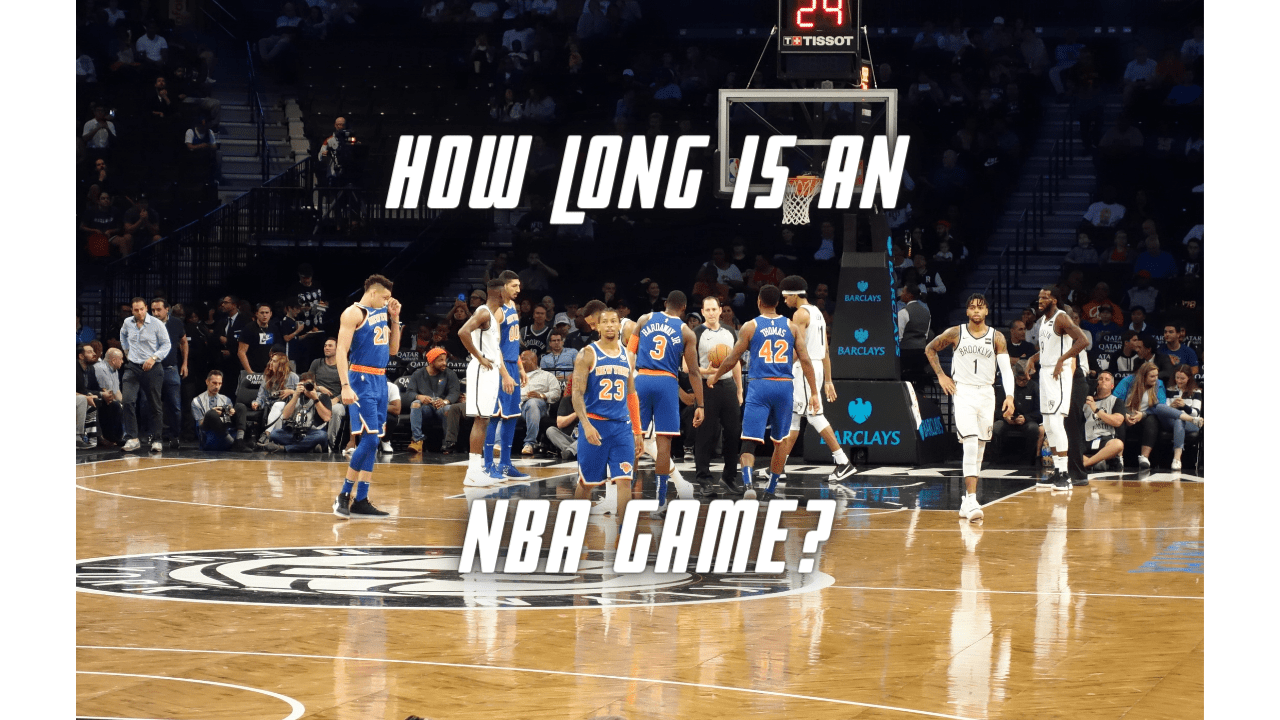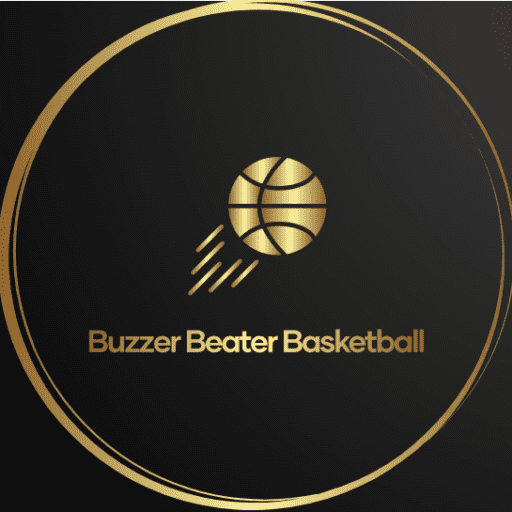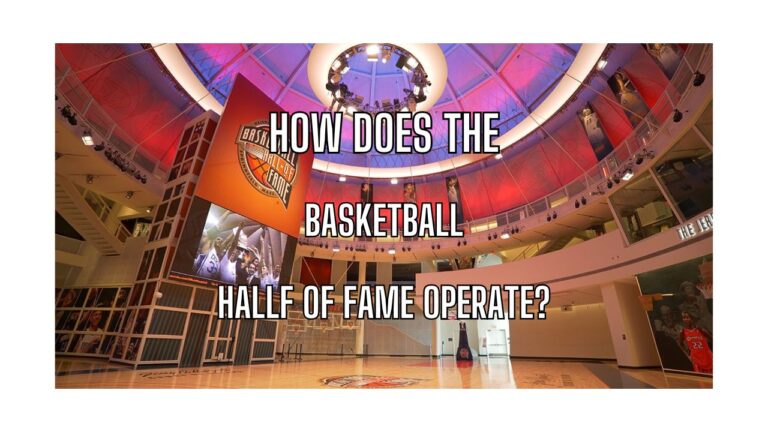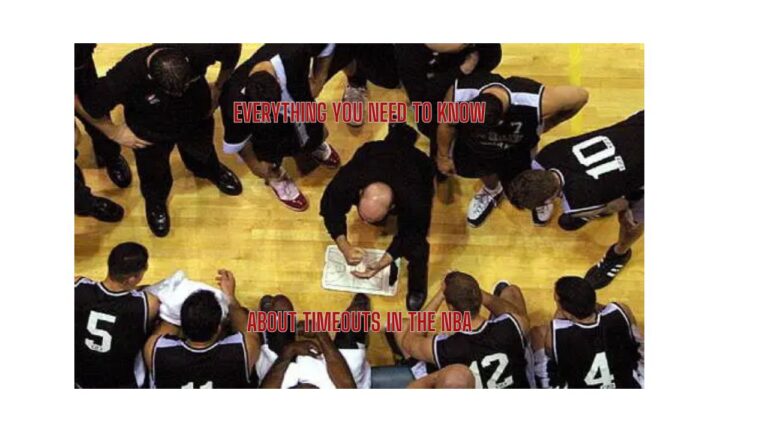
In the world of basketball, NBA games are an athletic battle of attrition. Not only do they boast the longest playing time during regulation than other leagues around the world, but they also tend to stretch longer than many other sporting events.
Duration of an NBA Game
How long are NBA games? An NBA contest comprises four quarters, each lasting a demanding 12 minutes, summing up to a grueling 48 minutes of intense court action. Should the game be deadlocked at the end of regulation, additional five-minute overtime periods are played indefinitely until a victor emerges. There’s no limit to the number of overtimes a game can undergo before it’s deemed a tie.
However, it’s important to note that these figures strictly pertain to actual gameplay minutes. When factoring in the myriad stoppages inherent in the televised NBA spectacle—timeouts, free throws, dead balls, quarter breaks, halftime intermissions, and the natural ebb and flow of the game—the average duration of an NBA match typically extends between 2 to 2.5 hours. Between the 1st and 2nd quarters there is a 2 and half minute break and the same for between quarters 3 and 4 however if the game happens to be a nationally televised game these breaks will be 3 and a half minutes for extra advertising revenue for the league. During these breaks coaches and players can rest and plan strategy.
Game Protocol
Preceding tip-off, coaches from both teams meticulously submit their player rosters, encompassing jersey numbers and names of players, coaches, trainers, and staff. After finalizing the list, five players are designated for the starting lineup, and the score sheet is verified.
Twenty minutes prior to game time, the home team exercises its privilege of designating the primary referee and selecting their bench and basket.
The commencement of the game is signaled by the shrill blast of the referee’s whistle. As players take their positions on the court, the referee initiates play by lofting the ball high above the center circle. The timed game officially begins the moment any player establishes contact with the ball.
Comparison to Other League
Shot Clock: In NBA games, a 24-second shot clock dictates the pace of play, a rule mirrored by FIBA, the international basketball governing body. Conversely, the WNBA and college basketball employ a slightly extended shot clock of 30 seconds, while certain high school games adhere to a 35-second shot clock.
Game Duration Breakdown:
- NBA: 4 quarters of 12 minutes each, totaling 48 minutes.
- FIBA and Women’s College Basketball: 4 quarters of 10 minutes each, resulting in a 40-minute game.
- WNBA and Men’s College Basketball: 2 halves of 20 minutes each, also amounting to a 40-minute game.
Longest Games in History
The NBA witnessed its longest game back in 1951 when the Rochester Royals clashed with the Indianapolis Olympians, enduring a marathon six overtimes, culminating in a staggering 78-minute affair that ended in a close 75-73 finish with the Olympians winning the game. Unfortunately there is no footage of this game due to when it wasplayed. In recent times on May 3rd 2019 the Portland Trailblazers and Denver Nuggets had a 4 overtime game with highlights you can watch embedded below
Remarkably, college basketball shares a similar tale of endurance. On March 12th 2009 The Big East tournament bore witness to a colossal showdown between Syracuse and UCONN, stretching to an unprecedented six overtimes, spanning a grueling 70 minutes of on-court action. Syracuse came out on top and pulled off the upset highlights of which you can see in the video embedded to the right
What Factors Affect The Length Of An NBA Game?
Whether you are a fan who needs to know how much time they need to set aside to watch an NBA contest or A player/coach its important to know how much time to set aside for the activity and what factors could influence the length of an NBA game. Whilst the on court action in an NBA game is 48 minutes it usually takes 2 to 2 and a half hours for an NBA game. The factors that influence this are:
Injuries
Injuries can significantly impact the course of an NBA game, leading to delays or interruptions in gameplay. Here’s how injuries can cause delays during an NBA game, along with examples:
-
Injury Timeout:
When a player suffers an injury on the court, the game is typically paused to allow medical staff to assess and treat the injured player. This can lead to a delay in gameplay as the injured player receives medical attention.One example of this would be the scary fall of Nerlons Noel where he needed to be assessed on the court after a hard fall as shown below
-
Cleanup and Sanitization:
Injuries that result in bleeding or bodily fluids on the court require immediate cleanup and sanitization to ensure the safety of players and officials. This process can take some time and may delay the game.Example: In a game between the Houston Rockets and the Milwaukee Bucks, Rockets’ forward PJ Tucker suffered a facial injury that caused bleeding on the court. The game was halted while arena staff cleaned and sanitized the affected area before play could resume.
-
Player Substitutions:
Injuries may necessitate player substitutions, requiring coaches to make adjustments to their lineups. This process can take some time, especially if the injured player needs assistance leaving the court.Example: In a matchup between the Brooklyn Nets and the Boston Celtics, Nets’ guard Kyrie Irving suffered a knee injury in the first quarter. The game was delayed as Irving was helped off the court, and the Nets’ coaching staff made substitutions to replace him in the lineup.
-
Emotional Impact and Momentum Shifts:
Injuries can also have a psychological impact on players, coaches, and fans, leading to emotional moments and shifts in momentum. This can result in brief pauses or delays as individuals process the situation.Example: During a heated playoff game between the Toronto Raptors and the Philadelphia 76ers, Raptors’ forward Pascal Siakam collided with an opponent and suffered a shoulder injury. The game was briefly delayed as Siakam received medical attention, leading to an emotional moment as teammates and fans rallied behind him.
Timeouts and Commercial Breaks
Timeouts and commercial breaks are pivotal elements that shape the duration and rhythm of NBA games. These strategic pauses not only provide teams with opportunities to regroup and adjust their strategies but also serve as revenue-generating platforms through commercial advertising. Understanding the interplay between timeouts, commercial breaks, and their impact on the flow of the game is essential in comprehending the dynamics of NBA contests. Teams use times out to plan,change or execute new strategies and players use them to strategise and more importantly get a rest.
In the NBA, each team is allowed a specific number of timeouts per game. Here are the timeout rules in the NBA.
Each team is granted a maximum of seven timeouts per game. These timeouts can be used at any point during regulation play or overtime periods. As per the official regulations outlined in the NBA rulebook, every team possesses a quota of seven timeouts during standard regulation gameplay. However, there are specific restrictions applied to timeout usage, particularly in critical game moments.In the pivotal fourth quarter, teams are allotted only four timeouts, with a further reduction to two timeouts within the final three minutes of regulation play. Should the game extend into overtime, each team is granted an additional two timeouts.
It’s worth noting that the duration of each timeout has been standardized to 75 seconds. Since the commencement of the 2017-18 season, the distinction between full timeouts and 20-second timeouts has been eliminated, streamlining the timeout format.Moreover, the league introduced a noteworthy regulation change during the 2017-18 season, mandating mandatory timeouts at designated intervals throughout the game. These adjustments aim to enhance the flow and pacing of NBA matches while ensuring equitable opportunities for strategic breaks in the action and advertising revenue. In overtime periods, each team is granted additional timeouts. Teams receive one additional full timeout in each overtime period.Unused timeouts do not carry over from one half to the next or from regulation play to overtime periods. Any unused timeouts are forfeited at the end of each half or overtime period. There are also rules in place on when a time can take a timeout which can be viewed directly from the NBA.com rulebook here.
Fouls, Free Throws and Altercations
Fouls play a significant role in shaping the duration and rhythm of an NBA game. These infractions not only impact the flow of gameplay but also introduce additional stoppages and free throw opportunities that can extend the length of the contest. Understanding the implications of fouls on game length is essential in comprehending the dynamics of NBA matchup and understanding why NBA games take as long as they do.
Foul Calls and Stoppage of Play:
Fouls result in the stoppage of play, as referees blow their whistles to signal the infraction. This pause allows officials to assess the situation, determine the severity of the foul, and administer appropriate penalties.
Depending on the nature of the foul, play may resume immediately with an inbound pass or be followed by free throw attempts for the fouled player or team.
Free Throw Opportunities:
Many fouls in basketball result in free throw opportunities for the fouled player or team. These free throws are awarded as penalty shots for the opposing team’s foul.
Each free throw attempt involves the fouled player shooting from the free throw line, uncontested by defenders. The number of free throws awarded depends on the type of foul and the situation.
Timeouts and Substitutions:
Fouls can also influence the strategic use of timeouts and player substitutions. Coaches may choose to call timeouts to manage foul trouble, rest key players, or strategize during critical moments of the game.
Additionally, teams may make substitutions to replace players who have accumulated multiple fouls or are at risk of fouling out of the game.
Foul Limits and Disqualification:
In the NBA, players are subject to personal foul limits, typically set at six fouls per player. Once a player reaches the foul limit, they are disqualified from further participation in the game.
Foul disqualifications necessitate player substitutions and can impact team dynamics, especially if key players are sidelined due to foul trouble.
Foul-Related Delays:
The process of assessing fouls, administering free throws, and managing player substitutions can lead to delays in gameplay. These interruptions contribute to the overall length of the game and may affect its pacing and rhythm.
Foul-related delays can be exacerbated in closely contested games or during high-pressure situations, where fouls occur more frequently as teams vie for control and momentum.
Altercations and Fights:
In the heat of competition athletes can get heated and fights can break out, obviously play cannot continue until order has been restored. This is usually done pretty fast but in some cases proves to be impossible. The Infamous “Malice at the Palace” incident from Detroit comes to mind which you can see below.
The Impact of Quarter Breaks and Halftime on NBA Game Length
In the realm of NBA basketball, the dynamics of gameplay extend beyond the action on the court, encompassing strategic timeouts, player rotations, and crucial breaks between quarters.
How Long Is The Break Between NBA Quarters?
Between each quarter of an NBA game, there are designated stoppages in play, providing teams with brief respites to regroup, strategize, and make necessary adjustments. These intermissions, while relatively short, play a pivotal role in influencing the pacing and rhythm of the game.
The duration of quarter breaks varies slightly depending on the nature of the game. For regular games, quarter breaks typically last for 2 minutes and 30 seconds, allowing players and coaches a brief opportunity to catch their breath and reassess their game plan. However, for nationally-televised games, such as marquee matchups or primetime broadcasts, quarter breaks may be extended to 3 minutes and 30 seconds to accommodate additional commercial breaks and promotional activities.
How Long Is NBA Half Time?
Halftime serves as the midpoint of an NBA game, occurring after the conclusion of the second quarter. Unlike quarter breaks, halftime offers players and teams a more substantial break from the intensity of gameplay. Lasting for 15 minutes, halftime provides players with ample time to rest, hydrate, receive medical treatment if necessary, and engage in halftime adjustments and discussions with coaches.
The extended duration of halftime distinguishes it from other breaks in the game and serves as a critical juncture for teams to assess their performance, make strategic adjustments, and refocus for the remainder of the contest. Additionally, halftime provides fans with an opportunity to enjoy entertainment performances, analyze game highlights, and partake in concession offerings, enhancing the overall fan experience.
How Do Close Games Affect NBA Game Length?
The intensity of a game, whether it’s a tight showdown or a one-sided affair, serves as a significant determinant of its duration. It’s been observed that games decided by fewer points tend to stretch longer than blowout victories. In nail-biting encounters, coaches are inclined to utilize all available timeouts strategically, employing frequent substitutions to maximize their team’s chances of victory. These strategic pauses, coupled with intentional fouling tactics to stop the clock, contribute to the elongation of game time, as teams vie for the upper hand in the final moments.
Moreover, the postseason landscape introduces additional variables that impact game length. Playoff matchups, fraught with heightened stakes and fervent competition, often unfold over longer durations compared to regular season games. The heightened drama and increased commercial breaks associated with postseason broadcasts result in extended game times, as networks capitalize on the heightened viewer interest to maximize advertising revenue.
Beyond strategic timeouts and intentional fouls, other game-related factors contribute to the lengthening of NBA contests. Injuries, though unfortunate, necessitate stoppages in play as medical staff tend to the injured player, prolonging the game duration. Additionally, instances of rule violations, such as the enforcement of the five-second inbound rule in close games, serve to extend the runtime as teams vie for possession in critical moments.
How Has NBA Game Length Changed Over Time?
The intensity of a game, whether it’s a tight showdown or a one-sided affair, serves as a significant determinant of its duration. It’s been observed that games decided by fewer points tend to stretch longer than blowout victories. In nail-biting encounters, coaches are inclined to utilize all available timeouts strategically, employing frequent substitutions to maximize their team’s chances of victory. These strategic pauses, coupled with intentional fouling tactics to stop the clock, contribute to the extension of game time, as teams vie for the upper hand in the final moments.
Moreover, the postseason landscape introduces additional variables that impact game length. Playoff matchups, fraught with heightened stakes and fervent competition, often unfold over longer durations compared to regular season games. The heightened drama and increased commercial breaks associated with postseason broadcasts result in extended game times, as networks capitalize on the heightened viewer interest to maximize advertising revenue.
Beyond strategic timeouts and intentional fouls, other game-related factors contribute to the lengthening of NBA contests. Injuries, though unfortunate, necessitate stoppages in play as medical staff tend to the injured player, prolonging the game duration. Additionally, instances of rule violations, such as the enforcement of the five-second inbound rule in close games, serve to extend the runtime as teams vie for possession in critical moments.
Comparing NBA Game Length To Other Sports
Expanding on the comparison of NBA games with other major sports:
NBA Game Length Compared to NHL Hockey:
- NHL games typically last around 2.5 to 3 hours, including stoppages and intermissions.
- Similar to NBA games, NHL matches feature frequent stoppages in play, including timeouts, penalties, and commercial breaks. Intermissions between periods provide teams with opportunities to regroup and strategize, further extending the runtime of hockey games.
NBA Game Length Compared to Tennis:
- Tennis matches unfold at a pace dictated by the players’ skill and endurance. The duration of tennis matches can vary widely, ranging from quick straight-set victories to epic five-set marathons.
- With no set time limit, tennis matches can last several hours or even stretch into multiple days during Grand Slam tournaments. The format of sets and games, coupled with the potential for tiebreakers and lengthy rallies, adds to the variability in match duration.
NBA Game Length Compared to Golf:
- Golf tournaments, such as those on the PGA Tour, span multiple days and consist of rounds played over 18 holes each day.
- A single round of golf can take anywhere from four to six hours to complete, depending on factors such as course difficulty, weather conditions, and the pace of play. Additionally, tournaments often feature multiple rounds spread across consecutive days, resulting in a cumulative viewing experience that extends over an entire weekend or longer.
NBA Game Length Compared to Motorsports:
- Motorsport events, including Formula 1 races and NASCAR competitions, vary in duration depending on the track length and race format.
- Formula 1 races typically last around two hours, while NASCAR races can range from a few hours for short-track events to several hours for longer races like the Daytona 500 or Le Mans 24 Hour Race. Factors such as caution periods, pit stops, and race strategies contribute to the overall duration of motorsport events. These events can dwarf the length of NBA games.
NBA Game Length Compared to Olympic Events:
- Olympic sporting events encompass a diverse range of disciplines, each with its own unique duration and format.
- Events like track and field competitions, swimming races, and gymnastics routines are typically short in duration, lasting a matter of minutes. In contrast, endurance events like marathons and cycling road races can span several hours. The Olympic Games, with their multi-sport format and extensive coverage, offer a varied viewing experience that caters to a global audience.
Frequently Asked Questions About NBA Game Duration
-
Why do NBA games seem to last longer than other sports events?
- NBA games often have extended durations due to frequent stoppages in play for timeouts, fouls, and commercial breaks. These breaks contribute to the overall length of the game.
-
What is the average duration of an NBA game?
- On average, NBA games last around 2 to 2.5 hours, including breaks and stoppages.
-
How do NBA game durations compare to other major sports leagues?
- NBA games are generally longer than sports like soccer and tennis but shorter than NFL football and MLB baseball games.
-
What factors contribute to the extended runtime of NBA games?
- Strategic timeouts, fouls, commercial breaks, and halftime intermissions all contribute to the length of NBA contests.
-
Are there any rule changes or initiatives aimed at managing NBA game length?
- Yes, the NBA has implemented measures such as limiting timeouts in the final minutes and reducing the shot clock following offensive rebounds to streamline gameplay.
-
Do playoff games have longer durations compared to regular season games?
- Yes, playoff games tend to have longer durations due to heightened stakes, increased commercial breaks, and extended timeouts.
-
How do close games versus blowouts impact the length of NBA games?
- Close games often involve more timeouts, strategic fouls, and stoppages, leading to longer durations compared to blowout victories.
-
Are there any technological advancements that affect NBA game length?
- Yes, advancements in technology, such as video reviews and slow-motion replays, introduce additional breaks in gameplay, contributing to longer game durations.
-
What role do injuries play in NBA game length?
- Injuries can lead to stoppages in play as medical staff attend to injured players, extending the overall duration of games.
-
Is there a trend towards shorter NBA games in recent years?
- While the NBA has introduced initiatives to manage game length, such as reducing the shot clock and limiting timeouts, the average duration of NBA games has remained relatively consistent over the years.
-
Are there specific quarters or periods in NBA games where the duration tends to be longer?
- Yes, the fourth quarter often sees extended durations due to strategic timeouts and fouls as teams jockey for position in close games.
-
How do television broadcasts affect the length of NBA games?
- Television broadcasts often include additional commercial breaks and promotional activities, which can extend the overall duration of NBA games.
-
Do NBA games have a set time limit for each quarter?
- Each quarter in an NBA game has a scheduled duration of 12 minutes, but stoppages in play can lead to variations in actual game time.
-
What impact do player substitutions have on the length of NBA games?
- Player substitutions can lead to brief stoppages in play, particularly during timeouts and quarter breaks, contributing to the overall duration of games.
-
Are there differences in game length between regular season and preseason NBA games?
- Preseason NBA games often have shorter durations as teams experiment with different lineups and playing strategies.
-
How do international NBA games, such as those played in other countries, compare in length to domestic games?
- International NBA games may have similar durations to domestic games, but factors such as travel logistics and venue differences can affect overall game length.
-
Are there any penalties for teams that exceed the allotted time for timeouts or halftime intermissions?
- While there are no direct penalties for exceeding timeouts or halftime intermissions, delays can lead to fines or other disciplinary actions from the league.
-
Do NBA games have a time limit for halftime entertainment performances?
- Halftime entertainment performances typically have a designated time limit to ensure that games resume promptly after the intermission.
-
How do game delays, such as technical difficulties or court maintenance, impact the length of NBA games?
- Game delays can lead to extended durations as teams and officials wait for issues to be resolved before play can resume.
-
What role do referees play in managing the pace and duration of NBA games?
- Referees enforce rules and regulations to maintain the flow of the game, but their decisions, such as calling fouls or allowing additional timeouts, can affect game length.
If you want to know more about the NBA why not check out How Many Players Are There In The NBA?



